There was once a Ribbon Mill in West Radford beside of Clover Creamery Company (1922), and When I was around four or five My dad worked the evening shift there as a maintenace man but the the plant was not in operation during the evenings so he would take me with him.We would walk from home which was about a thirty-five minute walk and I can remember exploring all around inside that long building and it was pretty dark in some of the rooms at night but I would spend hours playing with the different size wood spools.
My dad would always take me over to the milk creamery at lunch break and I can remember singing to the workers there and they would give me a big glass container of Chocolate milk and an ice cream.
The Clover Creamery Company (1922), was in business until the early 70's I think and I can remember when they ran home delivery trucks to the homes and bring the milk right to the door.
Radford Virginia Memories
A trip dowm memory lane about being born and raised in Radford Virginia in the 1950's.
Tuesday, March 30, 2010
Tuesday, March 23, 2010
Where is Yesterday ?
It seems as only yesterday,There was only fours hours of television in the afternoon that started about 4:30 pm and then the entire station would shut down around 8:30 at night.
In the town people would be walking the streets and gazing into the shop windows or sitting in their cars on the street watching people pasting by while eating hotdogs they just bought 20 for a buck along with a 10 cent coke.
A a few times during the week the air raid sirens would sound and all the lights in the area would go out and for small kid like me it would be one of the scariest time in my life and alot of times I would run and hide behind our big stand -up radio. After the alert was over and the lights were turned back on by that time it was time for bed because mom and dad were always up by 4:30 and the smell of bacon and eggs cooking and coffee in the old perculator would certainly wake you up.
In the town people would be walking the streets and gazing into the shop windows or sitting in their cars on the street watching people pasting by while eating hotdogs they just bought 20 for a buck along with a 10 cent coke.
A a few times during the week the air raid sirens would sound and all the lights in the area would go out and for small kid like me it would be one of the scariest time in my life and alot of times I would run and hide behind our big stand -up radio. After the alert was over and the lights were turned back on by that time it was time for bed because mom and dad were always up by 4:30 and the smell of bacon and eggs cooking and coffee in the old perculator would certainly wake you up.
Subscribe to:
Posts (Atom)
New River Bridge
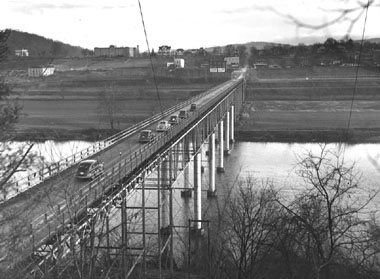
A city changes
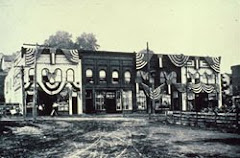
New River Bridge 1940

Yesterdays stores
I remember walking into the grocery store with my dad and there would be wood barrels filled with crakers and you would get as many as you would need or there were small barrels of pickles.Bologna was in big rolls and you would tell the meat cutter how much you wanted and there would be fresh chickens and some times fresh fish.There was always these little samples of loafs of bread in a barrel and they were free and of course all milk came in bottles and boy did it taste better back then.
There was an old flour mill along the New River and we would go there to get our fresh grind flour and corn mill. In thoses days we would go down into the river bottom and spend all day picking black berries and dry land grest or find apple trees and pick a bunch of them and then had to carry them all the way home.
There was an old flour mill along the New River and we would go there to get our fresh grind flour and corn mill. In thoses days we would go down into the river bottom and spend all day picking black berries and dry land grest or find apple trees and pick a bunch of them and then had to carry them all the way home.
Before Television
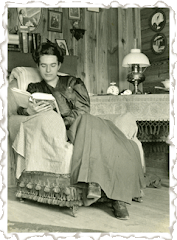
A Quite Saturday Afternoon
RADFORD 1950

A peaceful time
Radford memories
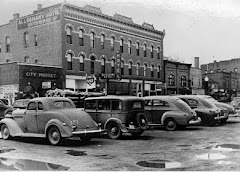
DownTown Radford
Ingles House
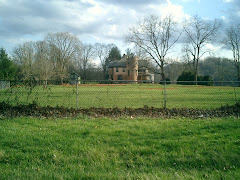
West Radford

The Old Signs
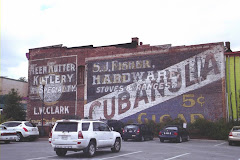
5 cent Cigar
Radford History
MY FACEBOOK
A lot more History on Radford.
History
Radford va virginia boating, mountain biking, canoeing, outdoor recreation
The first permanent settlement within Radford's present boundaries occurred at the New River crossing of the Wilderness Road. This trail extended westward from the valley of Virginia through southwest Virginia and on to the Cumberland Gap into Kentucky. This pathway became known as the Wilderness Road and with later development it became known as the Stagecoach Road. Stagecoach Road would later be called the Valley Pike and eventually what is now US 11. Radford's section of this road is known as Rock Road and here in 1762 William Ingles and his wife, Mary Draper Ingles, established Ingles' Ferry. The ferry became the nucleus of a commercial center which was to have, among other businesses, a tavern, blacksmith's shop and a general store.
The coming of the Virginia and Tennessee Railroad in 1854 brought a marked change in orientation for Radford. A depot was constructed at Lovely Mount and because it was situated halfway between Lynchburg and Bristol, it was named Central. Its midway location also led the railroad to build repair shops at Central stimulating residential and commercial growth in the village. When the railroad arrived, Lovely Mount had a population of 30. Two years later, when the first scheduled trains ran, there were over 100 people, a roundhouse, repair shop, workmen's homes, a tavern, restaurant and general store. Gradually trade was taken away from Lovely Mount Tavern and Central became the commercial center, serving as a shipping point for the area's products. These products consisted of tobacco, bacon and lumber.
In 1872, the New River Railroad, Mining and Manufacturing Company chartered to build a railroad from Central to the Pocahontas coal fields in West Virginia. It was 10 years before Pocahontas coal reached Central (the railroad by then operated by Norfolk and Western), but this enterprise, coupled with a road to the Cripple Creek iron mines, spurred a boom in Central. Land development Companies were formed and subdivisions planned. The Radford Land and Improvement Company developed much of the area that was to become West Radford. Several other companies developed East Radford and the area around the New River depot across the river. Industry was promoted and during this time an iron foundry, brick works, lumber companies, a knitting mill and a stone quarry came into being. Virginia Iron, Coal and Coke Company was a major employer. The population grew from 300 in 1880 to 3,000 in 1890. In 1885, Central City was incorporated as a town and in 1887; its name was officially changed to Radford. In 1888, the post office was moved from Lovely Mount Tavern to Radford, although it retained the Lovely Mount name until 1891 when it was changed to Radford. The following year, 1892, a post office was established west of Connelly's Run and also named Radford. Therefore, the first post office was again renamed, this time to East Radford. There were also two railroad stations constructed, one on either side of Connelly's Run. They were called Radford (east side) and West Radford. By 1892, the two Radfords merged politically and, having the required population of 5,000, attained city status.
The Panic of 1894 put an end to Radford's boom. The city population between 1890 and 1900, but in the twentieth century began slowly to grow again. Several Radford industries began between 1900 and 1930. These included Radford Ice Manufacturing Company (1916), Clover Creamery Company (1922), West End Milling (Lewis Harvey and Sons, owners), and Norfolk and Western Timber Preserving Plant (1921). The Lynchburg Foundry acquired the Radford Pipe Works (opened in 1892) in 1905.
The State Legislature selected Radford as the site for the State Normal School (later named Radford College) in 1913. This added a new element to the city's economy, but also a new divisive factor. East Radford had started as the commercial center and now was the educational center. West Radford was the industrial sector, although some of the city's finest homes were also there. A sometimes intense rivalry developed.
In an era when paved roads were scarce in Southwestern Virginia, it proved a boom to the city to secure the passage of the Lee Highway through its center in 1920. By 1928 there were fifteen industries in Radford employing 980 workers (Norfolk and Western and Lynchburg Foundry were the major employers) and 84 retail and wholesale establishments employing 245. Its population approaching 6,000, the city had three banks, three hotels, two motion picture theaters and two weekly newspapers. The decade saw the addition of a few other industries, including the New River Textiles, unit of Burlington Mills, and the Old Colony Box Company. Also, during this time Appalachian Power's Claytor Lake Dam was built which brought further economic modernization to the area.
During the 1930's the federal government had decided the Radford area was a choice site for a major industry requiring ample space, plentiful water, good transportation and a large work force. Radford "powder plant" or Arsenal was built in 1940-1941 to manufacture gunpowder and associated products. 10 War time employment exceeded 20,000. Three housing projects were developed in Radford to accommodate the rapid influx of people. These were Monroe Terrace, Radford Village, and Sunset Village. Fairlawn, which is the area across the river from Radford to Pulaski County, was also developed at this time. Hundreds of freight cars and no fewer than 12 passenger trains passed through Radford daily during the peak of the war time economy.
The rapid population growth (to 12,000 in 1943) necessitated change in city government as new and increased services were needed. New committees and boards were established and a fine recreation expansion and establishment of a Community Hospital and Chamber of Commerce.
The post-war years saw a sharp decline in population followed once again by slow increase. In 1957, the city joined the New River Valley Industrial Commission to help attract new industries to the city. Since then several companies have chosen to locate in Radford, among them the Inland Motors Division of Kollmorgen Corporation, Kenrose Manufacturing Company, Brad Ragan Rubber Company, which was originally the Graflo Rubber Company, and the RADVA Plastics Corporation. The growth of Radford College, given university status in 1979, has influenced the character and development of east Radford. The concern for education and juvenile after-hours behavior was the basis for Radford's achieving "All American city" status.
The railroad no longer dominates Radford. All passenger service was discontinued in 1971. The Radford section of Interstate 81, which was completed in 1965, bypassed the city and reduced US 11 to primarily local traffic. The hospital relocated from Radford to the neighboring county in 1999. Today Radford is a quaint small university town with a thriving business community made up primarily of specialty shops.
A bit of History of Radford
Located in Montgomery county, the town bore many names in its early nineteenth century history: Lovely Mount, English Ferry, Ingles's Ferry, Central Depot, and Central City all appear on early maps of the community. In 1885 Central City was formally incorporated and two years later, in 1887, the name was changed to Radford in honor of John Blair Radford, a prominent citizen of the community. Radford became a city in 1892. The United State Arsenal at Radford was one of the major weapons depots established by the federal government in Virginia during the twentieth century. Radford's municipal records date from 1892.
Drive-In Movie where I used to work
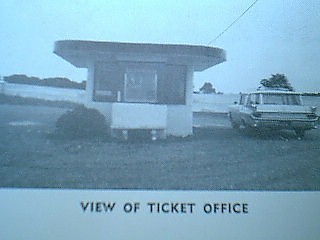
between Dublin and Pulaski
Facebook Badge
Amazon add
Old Round House 1897 Radford
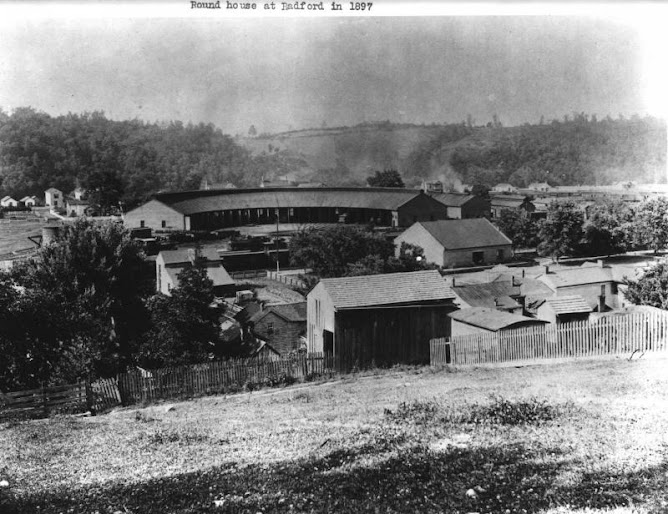
N&W RailRoad
Deals
Railroad Round House in 1897
Roundhouse at Radford, Virginia
Subject •Railroad
•Radford
•Virginia
•Roundhouse
work date 1897
current site NW 014
notes Neg#28128 Roundhouse at Radford 1897
source Norfolk & Western Historical Photograph Collection
Radford College 1927

MP3 Clips
Radford 1920
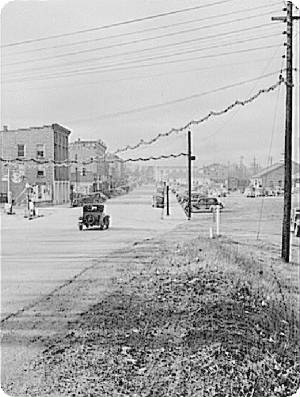
Peppers Ferry Tunnel
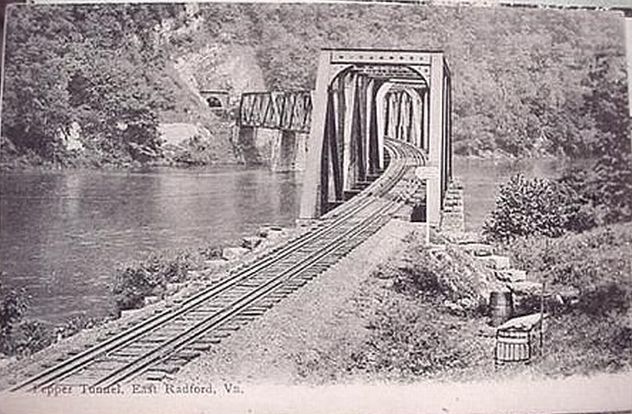
N & W RailRoad
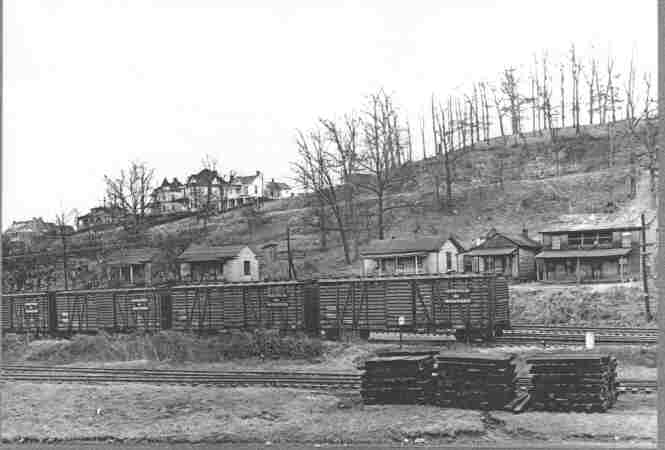
History About Radford College
Archives and Special Collections
A Narrative History of Radford University
The Beginning
The institution now known as Radford University was founded by the Virginia General Assembly in the Spring of 1910 as the "State Normal and Industrial School for Women at Radford" and was known more commonly as the "Radford Normal". The school grew out of a late nineteenth century effort to expand Virginia's public school system and to prepare a sufficient number of teachers for that system. The school was to be located on 33 acres in east Radford known as the "Heth Grove." On October 3, 1911, the school's Board of Trustees appointed Dr. John Preston McConnell as president of the institution.
The Administration Building, the first major construction on Radford's campus, was started in 1911 and completed in 14 months. Renamed Founder's Hall in the 1950s, the building was renowned for its ornate interior features and its distinctive copper dome, and was said to be one of the most notable structures between Roanoke and Bristol. Dedicated on August 9, 1913, the Administration Building housed administrative offices, a gymnasium, an auditorium, classrooms, the college library, and a swimming pool. President John McConnell and William Gilbert, professor of History, were the only two employees present at the dedication.
The school's first session opened on September 17, 1913. Students who arrived that fall had several options. Those who had come from 2- and 3- year high schools could complete their high school degree and earn up to a two-year Normal School Diploma. Students who had graduated from a 4-year high school could choose to pursue an "industrial" degree in the rural arts, household arts and manual arts. Courses were designed to give students a well- rounded education focused on teaching in the primary and secondary schools.
With no dormitories of its own, Radford Normal School rented two nearby buildings for student housing, Heth House and La Belle Inn. Life on campus was very strict and required the ladies to be "Southern Gentlewomen," observing Victorian values and prudence.
Dr. McConnell selected the school creed from an 1852 Daniel Webster quotation:
"If we work upon marble, it will perish.
If we work upon brass, time will efface it.
If we rear temples, they will crumble to dust.
But if we work upon men's immortal minds,
if we imbue them with high principles,
With the just fear of God and love of their fellowmen,
we engrave on those tablets
something which no time can efface,
and which will brighten and brighten to all eternity."
The school colors of purple and gray were chosen, a chapter of the Young Women's Christian Association (YWCA) was established, and an Alma Mater was written in 1913. The Student Government Association was established in 1914 and adopted the Honor System in 1917.
Alma Mater
Hail all Hail! To our Alma Mater
Bare our heads, make the welkin ring;
Hers our hearts and our fond allegiance
Honors to her we bring.
Praise her broad and lofty aim,
Her purpose ne'er will fail;
Hail to thee, our Alma Mater,
Hail, all Hail!
Hail, all Hail! To the Radford Normal
Give three cheers, and then one cheer more;
Let the praise of our Alma Mater
Echo from shore to shore;
She is ours and our loyalty
will never, never fail.
Hail to thee our Alma Mater,
Hail, all Hail!
Radford's campus continued to grow in the late teens and early 1920s. Tyler Hall, the school's first official residence hall, was built in three sections: the first opened in 1915, the second in 1916, and the third was completed in 1923. The Radnor, the school's first annual, was published from 1914-1917 and discontinued due to World War I. The successor to the Radnor, renamed the Beehive after the school seal, was first published in 1924. The Grapurchat, the first student newspaper, began in 1921.
Radford State Teachers College
In 1924, the school's name was changed to the Radford State Teachers College. For several years the curriculum had been undergoing revisions, high school courses had been dropped and the state had mandated that Radford focus on preparing teachers for rural school systems. While observing state guidelines, Dr. McConnell insisted that "good teaching required good courses whether it prepares teachers for rural or city schools." His dedication to equal opportunity for Radford's students continued throughout his presidency. Radford's first Bachelor of Science degrees had been awarded in 1921. The student teaching program had been expanded outside the city of Radford to the surrounding counties and towns. In 1928, Radford built its own training school, McGuffey Hall, now known as Whitt Hall, which is home to the College of Business and Economics.
The Student Activity Building, now known as Lucas Alumni Hall, was built soon after McGuffey Hall and contains many of the same architectural features. A majority of the funds for this facility had been donated by students, faculty, and staff over an eight-year period.
The first sorority chapter was established at Radford in 1929. Sigma Sigma Sigma (Tri Sigma) was founded with 25 students and heralded the beginning of a new social era of sororities and societies at Radford. The strong traditions of the Ingles and Pocahontas Societies were bid farewell as the main campus organizations. The names of the societies were commemorated in the naming of two residence halls in the early 1950s.
The May Day celebration, which had long been a popular spring athletic program, became more elaborate and formal in the mid-1930s. The crowning of a May Queen became the major campus social activity of the year. During the mid- and late-1930s, Radford's dedication to the advancement of education in Virginia continued with participation in the "Virginia New Curriculum." Progressive educational ideas and programs were instituted at the McGuffey training school, bringing teachers, supervisors, and education officials from across the state to Radford. The hope was to continue to enhance Radford's reputation as an excellent teaching facility in Virginia.
On November 15, 1937, Dr. McConnell resigned his position as president due to ill health. Mr. Jeremy Pate Whitt, the school's registrar, was named acting president until a successor could be chosen. Dr. David W. Peters assumed the role of president of Radford College on January 1, 1938.
Radford had come through the Depression relatively unscathed. In fact, several new initiatives had begun including the construction of McConnell Library, expansion of the stone wall which surrounded the campus, and the reconstruction of a log house, originally the birthplace of Mr. Whitt, which was to serve as a museum during its 20-year existence.
Many federal programs designed to improve the economy benefited the Radford campus during the 1930s. Improvements were made to existing buildings and a dining hall (present-day Walker Hall) was built in an area that was originally designated for Ingles and Pocahontas Society Homes. The Beehive yearbook was discontinued due to funding difficulties in 1930, but launched again in 1937.
War and Marriage
Dr. McConnell passed away on October 13, 1941, signaling the end of an era at Radford. The coming year brought World War II and caused disruptions on the campus with many of the faculty serving in the armed forces. A War Defense Council was organized in 1942 and campus programs were coordinated with the city. Classes were modified to focus on the war, including courses such as Geography for the War, War Craft Math, and PreFlight Aeronautics.
As the war progressed, Radford continued to survive through enrollment drops and further changes. In 1943 a merger was proposed between Radford and nearby Virginia Polytechnic Institute as part of a statewide effort to consolidate higher education institutions and give students the best opportunity for a broad professional and technical education. As the Women's Division of V.P.I., Radford students would have the opportunity to pursue the same programs available to men and duplicate courses were eliminated between the two schools.
Immediately following the war years, enrollment expanded at an amazing rate. Peacetime made money available for new construction and renovation. In 1948, Radford College began to expand outside the stone wall which had surrounded the campus for many years. Ingles Hall, a new dormitory, was completed in 1950, and in 1951 a new McGuffey school was constructed, reflecting modern elementary school design. The 1950s brought many physical changes, but a leadership change also took place when Dr. Peters passed away on August 2, 1951. Once more, Jeremy Whitt was asked to serve as acting president, a position he held until his own death just a few months later.
Dr. Charles Knox Martin, Jr. officially became Radford's third president on January 17, 1952. Under the Martin administration, Radford continued to grow and prosper throughout the 1950s with many additions, including Peters Hall and, after a struggle with the legislature, the construction of Pocahontas Hall.
50 Years and Growing
The 1960s began with a celebration of Radford's first half-century. The school had seen tremendous growth and expansion, three identity changes, three presidents and only one Dean of Women, M'Ledge Moffett, who retired as Dean of Women in 1962 after serving in that post since 1920. In 1964, due to the immense progress made at Radford, the "marriage" with V.P.I. was dissolved and Radford College dropped "the Women's Division of Virginia Polytechnic Institute" from its name. With restored autonomy came pressures for change from many external forces. The turbulent 1960s were a strange experience on the Radford campus, partly because many of the "finishing school" characteristics instituted 50 years earlier remained intact under the administration of President Charles Martin.
Students pushed for more and more freedoms at Radford, as they did at schools across the United States. One by one, many of the traditions which had defined Radford as a "Southern Gentlewoman's" school were abolished. The final major change that brought Radford into the present was the undergraduate admission of men in the summer of 1972.
In 1972, Dr. Martin retired from the presidency, assuming the position of college chancellor, which had been vacant since the split with Virginia Tech. Dr. Donald N. Dedmon took office on March 20, as Radford's fourth president. During Dr. Dedmon's administration, Radford College grew in stature and size to a comprehensive, coeducational institution. The fall 1972 semester academic year marked the first time that men were admitted for the full academic year rather than just for summer school as had been the practice in the school's first years in operation. In 1979, Radford was granted university status by the General Assembly, resulting in the school's fifth name change to Radford University. In celebration of the Scotch-Irish heritage of Southwest Virginia, the "Highlander" was also adopted in the 1970s as the nickname for the athletic teams. In keeping with the Scotch-Irish theme, the school colors were changed from the original purple and gray to the tartan plaid colors of red, white, blue and green. The school newspaper was renamed The Tartan and the literary magazine adopted the name Gaelic. The annual remained The Beehive.
Growth continued at a rapid pace through the 1980s with over 9,000 students attending RU per year by the end of the decade. The look and size of the campus also continued to evolve with the construction of a state-of-the-art sports complex named for Dr. Dedmon. The Dedmon Center was one of the first buildings designed with an inflated, air-supported roof, similar to that of the RCA Dome in Indianapolis. The location of the Dedmon Center was also a change for the campus, as new properties adjacent to the New River were acquired from the railroad.
In June 1994, after 22 years as president, Dr. Dedmon announced his retirement. Dr. Charles W. Owens, Vice President for Academic Affairs, was named acting president until a successor was found. After a national search, Dr. Douglas Covington was named the fifth president and took office in June of 1995. After ten years of outstanding service, Dr. Covington retired in June of 2005.
President Penelope Kyle
The Board of Visitors conducted a national search, and hired Penelope Kyle as Radford University's sixth president, and first female president, in June 2005. Upon assuming the presidency, President Kyle immediately focused on leading the university’s initiative to become one of the top 50 masters universities in the nation. The Radford University strategic plan “7-17”, completed in 2007 at her direction, identifies four strategic directives -- the investment in people, programs, global and local society and the future of Radford University.
Under President Kyle’s leadership, the university also added its first doctoral program with an emphasis in rural mental health and launched an initiative to grow graduate college student enrollment by offering additional doctoral and masters level programs. She hired the university’s first provost and created two new vice presidential areas of responsibility, Information Technology and University Relations. The Radford University Board of Visitors, at President Kyle’s request, has increased its membership by four positions to provide an opportunity for more diversity and leadership innovation within the governing body.
A native of southwest Virginia, President Kyle is a product of the Galax public schools system. She graduated from Guilford College in Greensboro, North Carolina and did her postgraduate studies in English at Southern Methodist University in Dallas, Texas. She received her Juris Doctorate from the University of Virginia School of Law and later earned her MBA from the College of William and Mary.


